JAPAN 英文简介
日本的介绍英语作文
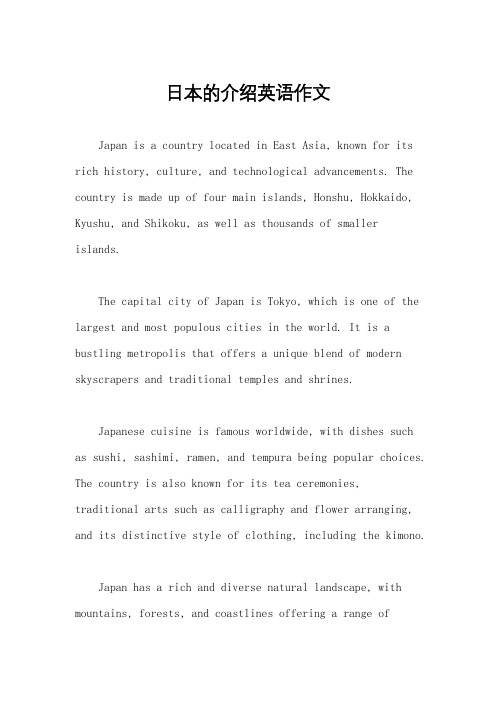
日本的介绍英语作文Japan is a country located in East Asia, known for its rich history, culture, and technological advancements. The country is made up of four main islands, Honshu, Hokkaido, Kyushu, and Shikoku, as well as thousands of smaller islands.The capital city of Japan is Tokyo, which is one of the largest and most populous cities in the world. It is a bustling metropolis that offers a unique blend of modern skyscrapers and traditional temples and shrines.Japanese cuisine is famous worldwide, with dishes such as sushi, sashimi, ramen, and tempura being popular choices. The country is also known for its tea ceremonies,traditional arts such as calligraphy and flower arranging, and its distinctive style of clothing, including the kimono.Japan has a rich and diverse natural landscape, with mountains, forests, and coastlines offering a range ofoutdoor activities such as hiking, skiing, and surfing. The country is also home to many hot springs, known as onsen, which are popular for relaxation and wellness.The Japanese people are known for their politeness, respect for tradition, and strong work ethic. They place a high value on harmony and community, and this is reflected in their social customs and everyday interactions.In recent years, Japan has been at the forefront of technological innovation, with companies such as Sony, Toyota, and Nintendo leading the way in areas such as electronics, automotive manufacturing, and video gaming.Overall, Japan is a country that offers a unique blend of ancient traditions and cutting-edge technology, making it a fascinating and diverse place to visit and explore.。
日本简介英文作文
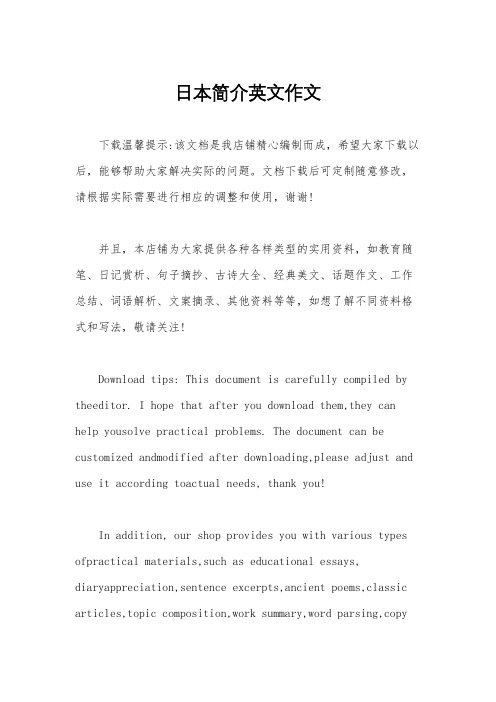
日本简介英文作文下载温馨提示:该文档是我店铺精心编制而成,希望大家下载以后,能够帮助大家解决实际的问题。
文档下载后可定制随意修改,请根据实际需要进行相应的调整和使用,谢谢!并且,本店铺为大家提供各种各样类型的实用资料,如教育随笔、日记赏析、句子摘抄、古诗大全、经典美文、话题作文、工作总结、词语解析、文案摘录、其他资料等等,如想了解不同资料格式和写法,敬请关注!Download tips: This document is carefully compiled by theeditor. I hope that after you download them,they can help yousolve practical problems. The document can be customized andmodified after downloading,please adjust and use it according toactual needs, thank you!In addition, our shop provides you with various types ofpractical materials,such as educational essays, diaryappreciation,sentence excerpts,ancient poems,classic articles,topic composition,work summary,word parsing,copyexcerpts,other materials and so on,want to know different data formats andwriting methods,please pay attention!Japan is a country of contrasts. On one hand, it is a land of ancient traditions and customs, with a rich history that stretches back thousands of years. On the other hand,it is a country at the forefront of modern technology and innovation, with bustling cities and a fast-paced lifestyle.The natural beauty of Japan is also a sight to behold. From the cherry blossoms in spring to the vibrant autumn foliage, the changing seasons bring a sense of wonder and delight to the country. Japan is also home to stunning landscapes, from the snow-capped peaks of Mount Fuji to the tranquil beaches of Okinawa.Japanese cuisine is famous around the world, and for good reason. From sushi to ramen, the food in Japan is diverse and delicious. Each region of the country has its own unique culinary specialties, and there is always something new and exciting to try.The people of Japan are known for their politeness and respect for others. Visitors to the country are often struck by the courtesy and helpfulness of the locals, making it a welcoming and hospitable place to visit.In conclusion, Japan is a country that offers a little bit of everything. Whether you are interested in history and tradition, modern technology, natural beauty, or delicious food, Japan has something to offer everyone. It is a truly unique and fascinating place to explore.。
Japan Introduction 日本的英文介绍

Disney Theme Park
Second Step
Disney Theme Park
•The most famous landmark for kids is the Disney Theme Park in Tokyo. It is the largest Theme Park in Asia and was modeled on American Disney Park.
Everybody konws the Diaoyu Islands trouble between China and Japan. But can you point out where the Diaoyu Islands is?
ቤተ መጻሕፍቲ ባይዱ
Language --Japanese
The Japanese writing system consists of 3 different character sets: ❖ Hiragana 平假名 ❖ Katakana 片假名 ❖ Kanji (several thousands of Chinese characters) 汉字
❖ Economic & Technology 经济与科技 ------------------------------------------梓燊
❖ Etiquette & Custom 礼仪习俗 ---------------------------------------------金天
❖ Anime 动漫 --------------------------------------------------永结
Asian
Japan
Pacific
北海道
日本--英文版介绍
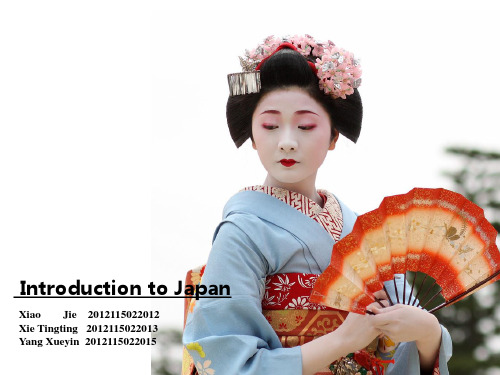
Wajin
As the height of the Yamato people is short they are called wajin (in chines 倭人) in our history.
History
• Emperor Jimmu was enthroned in 660 B.C. • February 11th is celebrated as the Foundation Day for the Japan. • Economic and cultural continue to develop in 645 from Innovation to Peaceful Period. • Meiji Restoration
THANK YOU ! >>
Xiao Jie 2012115022012 Xie Tingting 2012115022013 Yang Xueyin 2012115022015
Cherry blossom
● Cherry blossoms has 1000 years of history in Japan . ● The Japanese like enjoy the sight of the cherry blossoms and gradually formed a traditional folk customs.
Thousand Island Country
• 4 big islands:Hokkaido,Honshu,Shikoku,Kyushu • About 6800 small ones
Territorial Disputes
• Because of the Second World War,there is still some territorial disputes between Japan and its neighboring countries • Russian • South Korea • China
日本简介 英汉对照
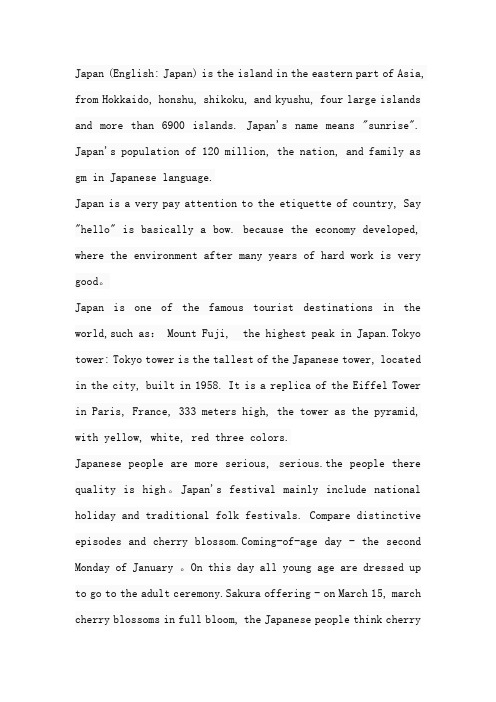
Japan (English: Japan) is the island in the eastern part of Asia, from Hokkaido, honshu, shikoku, and kyushu, four large islands and more than 6900 islands. Japan's name means "sunrise". Japan's population of 120 million, the nation, and family as gm in Japanese language.Japan is a very pay attention to the etiquette of country, Say "hello" is basically a bow. because the economy developed, where the environment after many years of hard work is very good。
Japan is one of the famous tourist destinations in the world,such as: Mount Fuji, the highest peak in Japan.Tokyo tower: Tokyo tower is the tallest of the Japanese tower, located in the city, built in 1958. It is a replica of the Eiffel Tower in Paris, France, 333 meters high, the tower as the pyramid, with yellow, white, red three colors.Japanese people are more serious, serious.the people there quality is high。
日本概况 英文版介绍
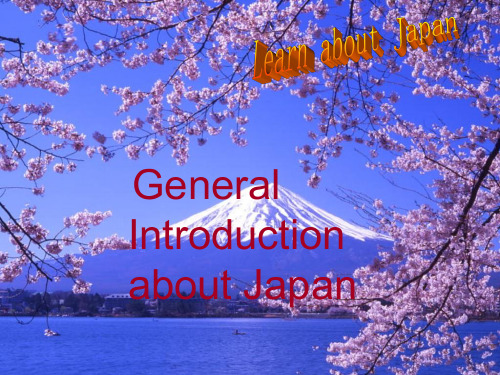
日本概况
Mount Fuji (Fuji Mountain) is 3,776 meters above the sea level, which is Japan's highest peak. The Japanese call it as the "sacred mountain ".It is a symbol of the Japanese nation. The mount is about 80 kilometers from Tokyo, an area of 90.76 square kilometers.
日本概况
Japan often suffers from natural disasters such as typhoons, volcanic eruptions, earthquakes and so on. Many of these disasters deprived of life, but over the years, Japanese have been pursued for the damage caused by the disaster to minimize the effort. At present, Japan's most cuttingedge technology is used to design earthquake-resistant building structures, and higher accuracy to track the storm informaarters of its territory is mountains, and its shape like a hippocampus; the rest are plains and basins, which are the major populated areas. Japan has East Japan Volcanic Belt and West Japan Volcanic Belt, is the world famous volcano country. 10% of the global earthquakes occurred in Japan and its surrounding areas every year .Japan's frequent earthquakes happened more than 1000 times a year, which is the most in the world.
日本英文简介作文

日本英文简介作文Japan is a fascinating country that has a unique blendof ancient traditions and modern technology. The country is located in East Asia and is made up of four main islands.It has a population of over 126 million people, making it the 10th largest country in the world by population. Japanis known for its rich history, beautiful landscapes, delicious cuisine, and unique culture.One of the most iconic symbols of Japan is Mount Fuji, which is the highest mountain in the country. It is located on Honshu, the largest of the four main islands, and is a popular destination for tourists and hikers. Mount Fuji is also considered a sacred site in Japan and is an important cultural symbol.Another important aspect of Japanese culture is its food. Japanese cuisine is known for its fresh and healthy ingredients, as well as its unique flavors and presentation. Some of the most popular dishes include sushi, ramen, udon,and tempura. Japanese food is not only delicious but also visually appealing, with many dishes being served in beautiful and intricate ways.Japan is also known for its technology and innovation. The country is home to many leading technology companies, such as Sony, Nintendo, and Panasonic. Japan is often at the forefront of new technological advancements, with inventions such as the bullet train, the Walkman, and the Nintendo Switch changing the world.Japanese culture is also deeply rooted in tradition and history. The country has a long and complex history, with many ancient traditions still being practiced today. Examples of these traditions include tea ceremonies, flower arrangement, and calligraphy. Japan is also known for its beautiful temples and shrines, such as the famous Fushimi Inari Shrine in Kyoto.In conclusion, Japan is a country that is rich in culture, history, and innovation. Its unique blend of ancient traditions and modern technology makes it afascinating destination for tourists and a leader in many industries. Whether it's climbing Mount Fuji, trying delicious sushi, or experiencing a traditional tea ceremony, there is something for everyone in Japan.。
japanese 日本介绍(英语)
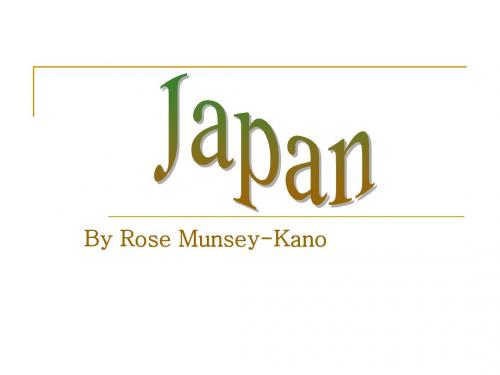
Japanese Writing
Japanese writing is very complex, and very beautiful. During the 4th century AD they developed their writing system, partially from their Chinese neighbors. Modern Japanese usually uses hiragana and katakana, but some kanji, too.
Mochi
Another example of the Japanese diet. Mochi is a chewy patty that is entirely made up of rice!
Bibliography
"Japan Travel Guide, Hotels, and Tourist information for holiday and vacation." Travel Guides | Online Tourist Information About Destinations. Web. 17 Jan. 2010. </japan/japan-travel-guide.asp>. "Imperial Palace, Tokyo, Japan | Japan Travel Guide." Travel Guides | Online Tourist Information About Destinations. Web. 17 Jan. 2010. </japan/Imperial-Palace+Tokyo.asp>. "Tokyo Imperial Palace." - Japan Travel and Living Guide. Web. 17 Jan. 2010. </e/e3017.html>. "| insomnia | japan | Bamboo forest." Insomnia | Videogame Culture. Web. 17 Jan. 2010. <http://insomnia.ac/japan/bamboo_forest/>. "Bamboo Forest, Arashiyama Park, Kyoto, Japan | Japan Travel Guide." Travel Guides | Online Tourist Information About Destinations. Web. 17 Jan. 2010. </japan/bamboo-forest-1.asp>. "MOUNT FUJI." Peace starts with a Smile. Web. 10 Dec. 2009. </2005/11/mountfuji.html>. "Japanese Gardens Listing Worldwide." Japanese Garden Design. Web. 10 Dec. 2009. </japanese_gardens/>. "The Five Gardens." Portland Japanese Garden. Web. 10 Dec. 2009. </gardens/>. "Mt. Fuji Facts and Information." Web. 11 Dec. 2009. <http://live-fuji.jp/fuji/scott/factinfo.html>. "Teamforce - DATSS Homepage." Teamforce - home. Web. 11 Dec. 2009. <https:///DATSS+Homepage>. "Japanese - hiragana, katakana, kanji, romaji." Omniglot - a guide to the languages, alphabets, syllabaries and other writing systems of the world. Web. 11 Jan. 2010. </writing/japanese.htm>. "Yiddish Music in Japanese?! -." Divrei Derech. Web. 12 Jan. 2010. </divrei_derech/2009/11/yiddish-music-in-japanese.html>. "Sumo." - Japan Travel and Living Guide. Web. 12 Jan. 2010. </e/e2080.html>. "Pictures of Japan - tokyo cityscape pictures - tokyo photo." Japan Travel Guide - Travel to Japan. Web. 12 Jan. 2010. </library/photo/bltokyo_cityscape17.htm>. "Fancy food show |." Tumblr. Web. 19 Jan. 2010. </tagged/fancy+food+show>.
介绍日本的英语作文初二

介绍日本的英语作文初二JapanJapan is an island nation in East Asia. It is located in the Pacific Ocean and consists of four main islands: Honshu, Hokkaido, Kyushu, and Shikoku. The country also has thousands of smaller islands. Japan is known for its rich history, unique culture, and advanced technology.The capital of Japan is Tokyo, which is one of the most populous cities in the world. The city is a hub of business, finance, and culture, and it is also home to the Japanese Imperial Family.Japanese culture is known for its traditional arts, such as tea ceremonies, calligraphy, and ikebana (flower arranging). Japan is also famous for its cuisine, including sushi, tempura, and ramen. The country has a rich traditionof music, dance, and theater, including the ancient art of Kabuki.Japan has a long history, and its ancient traditions coexist with modern technological advancements. The country has made significant contributions to the fields of robotics, electronics, and automotive manufacturing. Japanese companies such as Toyota, Sony, and Panasonic are world leaders intheir respective industries.In addition to its cultural and technological achievements, Japan is also known for its natural beauty. The country is home to stunning landscapes, including snow-capped mountains, lush forests, and beautiful beaches. Mount Fuji, the highest peak in Japan, is a famous symbol of the country and is a popular destination for tourists and hikers.One of Japan's most famous exports is anime and manga, which have a global following. These forms of entertainmentare a significant aspect of Japanese popular culture and have a dedicated fan base worldwide.Overall, Japan is a fascinating and diverse country, with a rich cultural heritage, stunning natural beauty, and a global impact on technology and popular culture. It continues to be a source of inspiration and fascination for people around the world.。
Japan日本英文简介
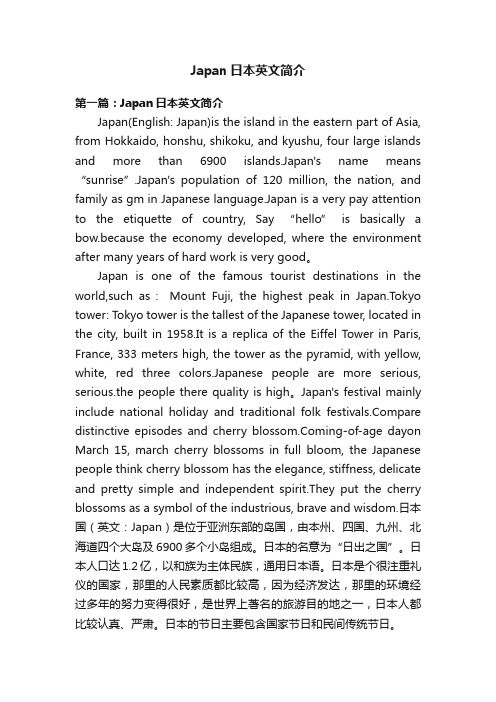
Japan日本英文简介第一篇:Japan日本英文简介Japan(English: Japan)is the island in the eastern part of Asia, from Hokkaido, honshu, shikoku, and kyushu, four large islands and more than 6900 islands.Japan's name means “sunrise”.Japan's population of 120 million, the nation, and family as gm in Japanese language.Japan is a very pay attention to the etiquette of country, Say “hello” is basically a bow.because the economy developed, where the environment after many years of hard work is very good。
Japan is one of the famous tourist destinations in the world,such as:Mount Fuji, the highest peak in Japan.Tokyo tower: Tokyo tower is the tallest of the Japanese tower, located in the city, built in 1958.It is a replica of the Eiffel Tower in Paris, France, 333 meters high, the tower as the pyramid, with yellow, white, red three colors.Japanese people are more serious, serious.the people there quality is high。
日本的英文简介作文

日本的英文简介作文英文:Japan is a unique country with a rich culture and history. It is an archipelago made up of four main islands and many smaller ones. The capital city is Tokyo, which is known for its bustling streets, bright lights, anddelicious food.One thing that sets Japan apart from other countries is its emphasis on politeness and respect. This can be seen in the way people address each other using honorifics, such as adding "-san" to someone's name. It is also evident in the way people bow to show respect.Another aspect of Japanese culture that I find fascinating is their love for nature. Japan has many beautiful parks and gardens, and the cherry blossom season is a particularly popular time to visit. The Japanese also have a deep respect for the environment and strive to livein harmony with nature.In terms of food, Japan is famous for its sushi, ramen, and tempura. However, there are many other delicious dishes to try, such as okonomiyaki and takoyaki. Japanese cuisine is known for its freshness and attention to detail.Overall, Japan is a wonderful country to visit. Its unique culture, delicious food, and friendly people make it a memorable destination.中文:日本是一个拥有丰富文化和历史的独特国家。
作文范文之日本英语作文
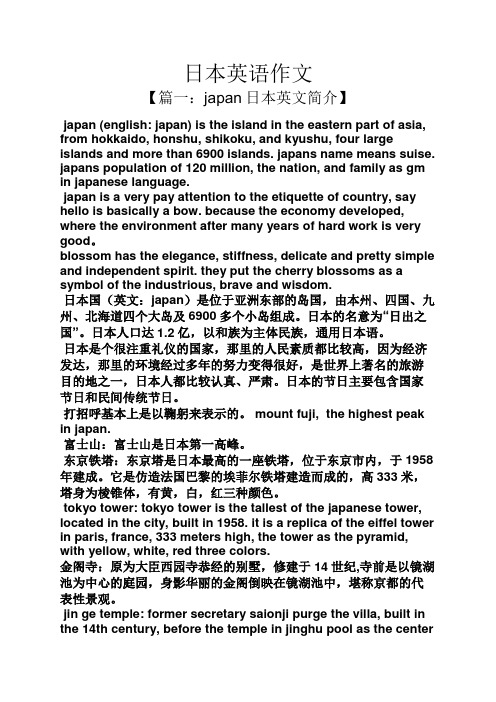
日本英语作文【篇一:japan日本英文简介】japan (english: japan) is the island in the eastern part of asia, from hokkaido, honshu, shikoku, and kyushu, four large islands and more than 6900 islands. japans name means suise. japans population of 120 million, the nation, and family as gm in japanese language.japan is a very pay attention to the etiquette of country, say hello is basically a bow. because the economy developed, where the environment after many years of hard work is very good。
blossom has the elegance, stiffness, delicate and pretty simple and independent spirit. they put the cherry blossoms as a symbol of the industrious, brave and wisdom.日本国(英文:japan)是位于亚洲东部的岛国,由本州、四国、九州、北海道四个大岛及6900多个小岛组成。
日本的名意为“日出之国”。
日本人口达1.2亿,以和族为主体民族,通用日本语。
日本是个很注重礼仪的国家,那里的人民素质都比较高,因为经济发达,那里的环境经过多年的努力变得很好,是世界上著名的旅游目的地之一,日本人都比较认真、严肃。
日本的节日主要包含国家节日和民间传统节日。
英文日本简介作文
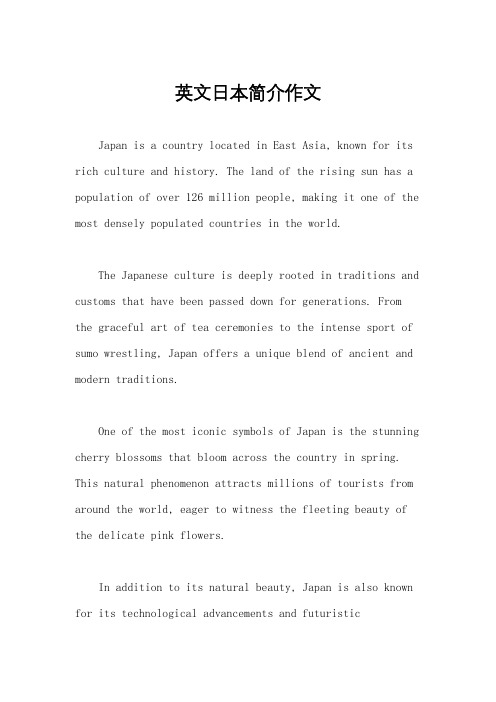
英文日本简介作文Japan is a country located in East Asia, known for its rich culture and history. The land of the rising sun has a population of over 126 million people, making it one of the most densely populated countries in the world.The Japanese culture is deeply rooted in traditions and customs that have been passed down for generations. From the graceful art of tea ceremonies to the intense sport of sumo wrestling, Japan offers a unique blend of ancient and modern traditions.One of the most iconic symbols of Japan is the stunning cherry blossoms that bloom across the country in spring. This natural phenomenon attracts millions of tourists from around the world, eager to witness the fleeting beauty of the delicate pink flowers.In addition to its natural beauty, Japan is also known for its technological advancements and futuristiccityscapes. From bullet trains to cutting-edge robotics, Japan is at the forefront of innovation and technology.Japanese cuisine is celebrated worldwide for its exquisite flavors and artistic presentation. Sushi, sashimi, tempura, and ramen are just a few examples of the diverse and delicious dishes that Japan has to offer.The country is also home to a vibrant pop culture scene, from anime and manga to J-pop and fashion. Japan'sinfluence on global entertainment and fashion is undeniable, with many people around the world embracing Japanese trends and styles.Despite its modernity, Japan has managed to preserveits traditional way of life and values. Respect for elders, harmony within society, and a strong work ethic are just a few of the principles that continue to shape Japanesesociety today.In conclusion, Japan is a fascinating and diverse country that seamlessly blends its rich history andtraditions with modern innovation and global influence. Whether you're drawn to its ancient temples and serene landscapes or its bustling cities and technological marvels, Japan has something to offer for everyone.。
日本的介绍英语作文
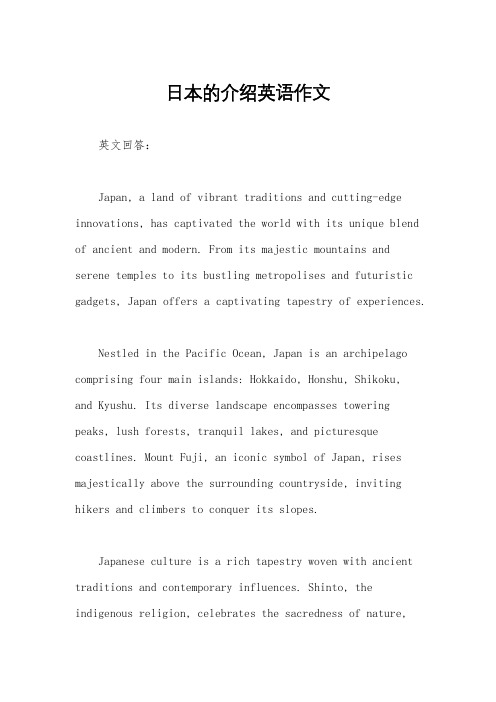
日本的介绍英语作文英文回答:Japan, a land of vibrant traditions and cutting-edge innovations, has captivated the world with its unique blend of ancient and modern. From its majestic mountains and serene temples to its bustling metropolises and futuristic gadgets, Japan offers a captivating tapestry of experiences.Nestled in the Pacific Ocean, Japan is an archipelago comprising four main islands: Hokkaido, Honshu, Shikoku,and Kyushu. Its diverse landscape encompasses towering peaks, lush forests, tranquil lakes, and picturesque coastlines. Mount Fuji, an iconic symbol of Japan, rises majestically above the surrounding countryside, inviting hikers and climbers to conquer its slopes.Japanese culture is a rich tapestry woven with ancient traditions and contemporary influences. Shinto, the indigenous religion, celebrates the sacredness of nature,while Buddhism, introduced from China in the 6th century, has profoundly influenced Japanese thought and art. The country is renowned for its exquisite tea ceremonies, intricate flower arrangements (ikebana), and traditional martial arts such as karate and judo.Japan's cities are a vibrant fusion of the old and the new. Tokyo, the bustling capital, is a global hub of commerce, fashion, and entertainment. Its skyscrapers soar into the heavens, casting long shadows over ancient temples and traditional neighborhoods. Kyoto, the former imperial capital, is a treasure trove of cultural and historical sites, including the iconic Golden Pavilion, a testament to the city's rich past.Japanese cuisine is a culinary delight, renowned forits freshness, simplicity, and subtle flavors. Sushi, a staple of Japanese dining, is a delicate balance of rice, seaweed, and raw fish or vegetables. Ramen, a hearty noodle soup, is another popular dish, enjoyed by locals andtourists alike. The country is also famous for itsexquisite wagyu beef, known for its marbling and tenderness.Beyond its cultural allure, Japan is a technological powerhouse. Its cutting-edge industries have produced groundbreaking products and innovations that have transformed the world. From the sleek Shinkansen bullet trains to the ubiquitous electronics that we rely on,Japan's technological prowess is a testament to its dedication to progress and innovation.As a traveler, Japan offers an unforgettable experience. Its friendly locals, rich culture, and scenic beauty makeit a destination that will leave a lasting impression. Whether you're exploring the bustling streets of Tokyo, soaking in the tranquility of Kyoto's temples, or marveling at the natural wonders of Mount Fuji, Japan promises an adventure that will ignite your senses and stay with you long after you leave.中文回答:日本,一个充满活力的传统与尖端创新相结合的国度,以其独特的古代和现代融合而吸引着世界人民。
Japan 日本概况英文版

JapanI. Brief IntroductionJapan is situated in northeastern Asia between the North Pacific and the Sea of Japan. The area of Japan is 377,873 square kilometers, nearly equivalent to Germany and Switzerland combined or slightly smaller than California. Japan consists of four major islands, surrounded by more than 4,000 smaller islands. The four major islands are Hokkaido(northern island), Honshu (main island), Shikoku (smallest island) and Kyushu (southern island). From north to south Japan's islands span 3,500 kilometres. At their closest points, Hokkaido is less than 45 kilometres from Sakhalin (Russia) and Kyushu is 200 kilometres from Korea. The largest island is Honshu, which accounts for about 60 per cent of the total area and contains Japan's major cities (Tokyo, Yokohama, Nagoya, Kyoto, Osaka and Kobe). About 70% of the land area is mountainous and mostly forested. Only 16% of Japan's surface is cultivated.The terrain is characterised by complex geographical features, with numerous hot springs and volcanoes. Mountain ranges separate the country into four zones. Since Japan is located in a region where several continental plates meet, the country experiences an average of 1,500 earthquakes each year - representing a tenth of the earth's seismic energy. Mt Fuji, Japan's most famous mountain and a dormant volcano, is also the highest, with an altitude of 3,776 metres.Japan’s natural scenery is truly diverse. The country is blessed with both mountains and seashores, and the climate varies richly from place to place and with each passing season. Spring is one of the best times of year to be in Japan. The temperatures are warm but not hot, there's not too much rain, and March-April brings the justly famous cherry blossoms (sakura) and is a time of revelry and festivals.Summer starts with a dreary rainy season (known as tsuyu or baiu) in June and turns into a steambath in July-August, with extreme humidity and the temperature heading as high as 40°C. Many Japanese enjoy bathing in the sea and relaxing at cool resorts in mountainous areas.Autumn, starting in September, is also an excellent time to be in Japan. Temperatures and humidity become more tolerable, fair days are common and fall colors can be just as impressive as cherry blossoms. However, in early autumn typhoons often hit the southern parts of Japan and bring everything to a standstill.Winter is from December to February. it is a good time to go skiing or hot-spring hopping, but as the Japanese have yet to figure out the wonders of central heating, it's often miserably cold indoorsJapan has not been well endowed with natural resources. Like a salesman’s sample case, Japan has a small amount of almost every kind of mineral, but not enough of each to be worth much . Almost 70 percent of Japan is covered with forests, and Japan is among the world’s leading producers of such products as wood pulp and paper. Japan’s greatest resource is its people, and they are the way they are very largely because of their history.With over 127 million people, Japan is the tenth most populous country in the world. The population density is approximately 335 persons per square kilometre,placing it among the world's most densely populated nations. Japan is a highly urbanised country, with approximately three in every four people living in cities. The population of the Tokyo Metropolitan Area including the city, some of its suburbs and the surrounding area is approximately 12 million. The Japanese today constitute a relatively homogeneous society, although there are some minority groups. These include approximately 640 000 Koreans, 290 000 Chinese, 225 000 Brazilians, 115 000 Filipinos and an ethnic minority group, the Ainu, whose numbers have dwindled to a few thousand and who are settled mainly in Hokkaido. There are about 290,000 other residents of foreign nationality.The Japanese are well known for their politeness. Many Japanese are thrilled to have visitors to their country and they will be incredibly helpful to a foreigner looking lost and bewildered. On the other hand many are not used to dealing with foreigners — commonly known as gaijin (外人, outsider), and you may find them reserved and reluctant to communicate.Japan's two major religions are Shinto (the indigenous religion of Japan) and Buddhism, which have co-existed for centuries. Some 84 per cent of the Japanese people consider themselves Buddhist, Shintoist or both. Taoism and Confucianism have also significantly influenced Japanese beliefs and mythology. A small minority (0.7 per cent) profess to Christianity (0.7 per cent) and other religions such as shamanism, Islam, and Hinduism (4.7 per cent).While religion no longer plays a major role in everyday life, the average Japanese will participate in religious rituals celebrating births, weddings and funerals, visit a shrine or temple at New Year and participate in local festivals (matsuri).At the same time, Shinto and Buddhism have had an enormous influence on the country's history and cultural life. The Shinto religion focuses on the spirit of the land, and is reflected in the country's exquisite gardens and peaceful shrines deep in ancient forests. When you visit a shrine (jinja 神社) with its simple torii (鳥居) gate, you are seeing Shinto customs and styles. If you see an empty plot of land with some white paper suspended in a square, that's a Shinto ceremony to dedicate the land for a new building.There is only one official language spoken in Japan, which is of course Japanese. However, many Japanese are able to understand English to a certain extent since English is the foreign language that everyone must learn as part of compulsory education, but it is not widely spoken.II. HistoryRecorded Japanese history begins in the 5th century, although archeaological evidence of settlement stretches back 500,000 years and the mythical Emperor Jimmu is said to have founded the current Imperial line in the 7th century BC. The first strong Japanese state was centered in Nara (8th c.), moving later to Kyoto and Kamakura until Japan descended into the anarchy of the Warring States period in the 15th century. Tokugawa Ieyasu finally reunified the country in 1600 and founded the Tokugawa shogunate, a feudal state ruled from Edo, or modern-day Tokyo. A strict caste system was imposed, with the Shogun and his samurai warriors at the top of theheap and no social mobility permitted.Tokugawa rule kept the country stable but stagnant with a policy of total isolation while the world around them rushed ahead. U.S. Commodore Matthew Perry's Black Ships arrived in Yokohama in 1854, forcing the country to open up to trade with the west. The resulting shock led to the collapse of the shogunate in the Meiji Restoration of 1867. Japan launched itself headlong into a drive to industrialize and modernize, which soon turned into a drive to expand and colonize its neighbors, culminating in the disastrous Second World War that saw 1.86 million Japanese and well over 10 million Chinese and other Asians die in battle, bombings, starvation and massacres. Forced to surrender in 1945 after the nuclear attacks of Hiroshima and Nagasaki, Japan was for the first time in its history occupied by the victorious Allies. The Emperor kept his throne but was turned into a constitutional monarch. Thus converted to pacifism and democracy, with the U.S. taking care of defense, Japan now directed its prodigious energies into peaceful technology and proceeded to conquer the world's marketplaces with an endless stream of cars and consumer electronics, rising from the ashes to attain the second-largest gross national product in the world.III. GovernmentThe lives of most Japanese are a blend of old Japanese ways and newer Western ways, and government is no exception. The Constitution of 1946 kept the emperor as symbolic head of state, but put real power into the Diet, the Japanese legislature or parliament, which consists of the House of Representatives (480 members) and the House of Councillors (242 members). The members of the Diet are elected by the Japanese people. As in the British system, The cabinet is headed by the Prime Minister. He is responsible to the Diet, and he appoints the Cabinet from among members of the Diet. Current prime minister is Shinzo Abe. The system of law courts, established during the Meiji period, was fashioned after French, German, and British models.IV. EconomyThe Japanese economy is one of the strongest in the world. Only the USA has a higher GNP. The Japanese currency is the Yen. Manufacturing, construction, distribution, real estate, services, and communication are Japan's major industries today. Agriculture makes up only about 2% of the GNP. Most important agricultural product is rice. Resources of raw materials are very limited and the mining industry rather small.Japan's main export goods are cars, electronic devices and computers. Japan has a large surplus in its export/import balance. The most important import goods are raw materials such as oil, foodstuffs, and wood.V. CultureJapan is one of the world's most ethnically and culturally homogeneous nations, but down the ages its culture and society have been greatly influenced by foreign ideas and institutions, art and literature. The wholesale importation of Chinesereligious and political institutions during the sixth century was followed by a long and essentially 'Japanese' feudal period, which was to last until the 19th century. EducationBased loosely on that of America, Japan’s educational system comprises six years of elementary school, three years of junior high school three years of senior high school and four years of university or two years of junior college. In addition there are kindergartens, five-year technical colleges for graduates of junior high school, and schools for the handicapped.Compulsory education includes elementary school and junior high school, although senior high school education is almost universal. Around 51 per cent of men and 49 per cent of women currently continue their studies at university. The Japanese school year starts in April and consists of three terms, separated by short holidays in spring and winter, and a one month-long summer break.A characteristic of the Japanese school system are its notoriously difficult entrance exams that schools set to determine who can enter, and with them a high competitiveness among students. Most high schools and universities, as well as a few private junior high schools and elementary schools, require applicants to write entrance exams. In order to pass entrance exams to the best institutions, many students attend special preparation schools (juku) besides regular classes, or for one to two years between high school and university (yobiko). The most prestigious universities are Tokyo's 'Big Six' universities and Kyoto University, followed by the best private universities.Arts and Craftssado( Japanese tea ceremony), the ceremony celebrating the Way of Tea, has been much favored by Japanese high society as an artistic ceremony. Today, it is popular as a means of training concentration of spirit and of learning manners. There are a number of schools in Japan, each presenting their own style of tea ceremony. Many hotels have a tea ceremony room on the grounds for the customers to enjoy a real tea ceremony.ikebana( flower arrangement),ikebana originated as a means to display wild flowers in the tea ceremony room, there are more than 20 schools of ikebana,all differing in their stuylistic rules and methods of presentation, and most have their own instruction center. You can enjoy the beauty of ikebana in a variety of places such as hotels, department stores and the lobbies of public buildings.KABUKI: the best known and most loved by people around the world, the traditional performing art of Kabuki is a more popular form of theatre than Noh. Rhythmical lines spoken by actors, colorful make-up and a stage full of mechanical devices for special effects are essential characteristic of Kabuki, but the more important is that all the roles, including those of women, are played by male actors.Noh: the highly stylized theater of Noh excludes the world of yugen, a deeply aesthetic value based on a profound and refined beauty that goes beyond words and concrete shapes. Its origin is in religious ritual and it has a long history of 700 years. Though the actor, dressed in traditional Japanese costume, either wears a mask to hide the expression on his face or performs without expression, his dance is lyrical andgraceful.BUNRAKU: it’s Puppet Theatre performed by three puppeteers.Architecture: the distinctive feature of a traditional Japanese building is the way in which the house is open to nature. The main materials used are wood, earth, and paper, and the construction spreads out sideways rather than upwards.Shrine architecture:The main sanctuary of a shrine is called the Shinden or Honden. There are also ancillary buildings such as the Haiden, or outer hall, and the Homotsuden, or treasury, but these are not arranged according to any particular specified layout.Sports: SUMO, KENDO, JUDO, KARATE and AIKIDOVI. Folk CustomsThe Japanese have inherited many customs, festivals, and holidays from the various religions. They like to celebrate such occasions, and they enjoy visiting historic shines and temples. A man might feel like a Christian on Christmas Day, a Shintoist at a wedding, and a Buddhist at a funeral. The rules that a Japanese is most used to following, however, come from the priests or monks, but from custom, from the family, and from government.Traditional Costumekimono( it is the traditional dress of Japan, and it is worn nowadays on formal occasions. It is sometimes accused of being an impractical form of dress, but it has the advantage of giving the wearer a graceful and elegant deportment. The shape of Kimono is fixed, and individuality is achieved by careful selection of the material, the style of weaving and dyeing, the color, and the pattern, as well as by the choice of obi. FoodSushi is a small piece of raw seafood placed on a ball of vinegared rice. The most common ingredients are tuna, squid and prawn. Cucumber, pickled radish and sweet egg omelet are also served.Sashimi is sliced raw fish eaten with soy sauce.Soba and Udon are two kinds of Japanese noodle. Soba is made from buckwheat flour and Udon from wheat flour. They are served either in a broth or dipped in a sauce, and are available in hundreds of delicious variations.Sukiyaki is prepared right at the table by cooking thinly sliced beef together with various vegetables, tofu and vermicelli.Tempura is food deep-fried in vegetable oil, after being coated with a mixture of egg, water and wheat flour. Among the ingredients used are prawns, fish in season and vegetables.HolidaysThe most important holiday in Japan is New Year (お正月Oshōgatsu), which pretty much shuts down the country between December 29 and January 3. Japanese head home to their families (which means massive transport congestion), eat festive foods and head out to the neighborhood temple at the stroke of midnight to wish in the New Year. Many Japanese often travel to other countries as well, and prices for airfares are very high.In March or April, Japanese head out en masse for hanami (花見, lit. "flower viewing"), a festival of outdoors picnics and drunken revelry in parks, cleverly disguised as cherry blossom (桜sakura) viewing. The exact timing of the famously fleeting blossoms varies from year to year and Japan's TV channels follow the progress of the cherry blossom front from south to north obsessively.The longest holiday is Golden Week (April 27 to May 6), when there are four public holidays within a week and everybody goes on extended vacation. Trains are crowded, flight and hotel prices are jacked up to multiples of normal prices, making this a bad time to travel in Japan, but the weeks immediately before or after GW are excellent choices.Summer brings a spate of festivals designed to distract people from the intolerable heat and humidity (comparable to the US Midwest). There are local festivals (祭matsuri) and impressive fireworks competitions (花火hanabi) throughout the country. Tanabata (七夕), on July 7th (or early August in some places), commemorates a story of star-crossed lovers who could only meet on this day. The largest summer festival is Obon (お盆), held in mid-July in eastern Japan (Kanto) and mid-August in western Japan (Kansai), which honors the departed spirits of one's ancestors. Everybody heads home to visit village graveyards, meaning that transport is packed.The following list shows the dates of Japanese national holidays.January 1 - New Year's Day (ganjitsu 元日)Second Monday of January - Coming-of-Age Day (seijin no hi 成人の日)February 11 - National Foundation Day (kenkoku kinenbi 建国記念の日)March 21 - Vernal Equinox Day (shunbun no hi 春分の日)April 29 - Showa Day (showa no hi 昭和の日)May 3 - Constitution Day (kenpō kinnenbi 憲法記念日)May 4 - Greenery Day (midori no hi 緑の日)May 5 - Children's Day (kodomo no hi 子供の日)Third Monday of July - Marine Day (umi no hi 海の日)Third Monday of September - Respect-for-the-Aged Day (keirō no hi 敬老の日) September 23 - Autumnal Equinox Day (shuubun no hi 秋分の日)Second Monday of October - Sports Day (taiiku no hi 体育の日)November 3 - Culture Day (bunka no hi 文化の日)November 23 - Labor Thanksgiving Day (kinrō kansha no hi 勤労感謝の日) December 23 - The Emperor's Birthday (tennō tanjōbi 天皇誕生日)VII. Scenic spotsJapan offers a very wide range of attractions, from historical and cultural treasures to modern and futuristic sights and beautiful forests, mountains and sea coasts.Japan has thousands of cities; these are nine of the most important to the traveler. Tokyo - the capital of Japan, modern and densely populated.Hiroshima - a large port city, the first city to be destroyed by an atom bomb Kanazawa - a historic city on the west coastKyoto - an ancient capital of Japan, considered the cultural heart of the country, with many ancient Buddhist temples and gardensNagasaki - an ancient port city in Kyushu,the second city to be destroyed by an atom bombNara - the first capital of a united Japan, with many Buddhist shrines, and historical buildingsOsaka - a large and dynamic city located in the Kansai regionSapporo - the largest city in Hokkaido, famous for its snow festivalSendai - the largest city in the Tohoku region, known as the city of forests due to its tree lined avenues and wooded hills.TokyoTokyo is Japan's capital and the country's largest city. Tokyo is also one of Japan's 47 prefectures, but is called a metropolis (to) rather than a prefecture (ken). The metropolis of Tokyo consists of 23 city wards (ku), 26 cities, 5 towns and 8 villages, including the Izu and Ogasawara Islands, several small Pacific Islands in the south of Japan's main island Honshu. The 23 city wards (ku) are the center of Tokyo and make up about one third of the metropolis' area, while housing roughly eight of Tokyo's approximately twelve million residents.Prior to 1868, Tokyo was known as Edo. A small castle town in the 16th century, Edo became Japan's political center in 1603 when Tokugawa Ieyasu established his feudal government there. A few decades later, Edo had grown into one of the world's most populous cities.With the Meiji Restoration of 1868, the emperor and capital were moved from Kyoto to Edo, which was renamed Tokyo ("Eastern Capital"). Large parts of Tokyo were destroyed in the Great Kanto Earthquake of 1923 and in the air raids of 1945.Attractions include Ginza (the famous shopping and entertainment district);Akihabara (shopping district for discount electronics);.Shiodome (a set of spectacular skyscrapers)Temples and ShrinesSensoji Temple (large temple in the Asakusa area).Meiji Shrine (shrine dedicated to the deity of Emperor Meiji)Yasukuni Shrine (shrine dedicated to the deities of Japan's war dead).Imperial Palace (the Imperial Palace is located in the center of Tokyo).Tokyo Tower (333 meter tall steel tower.)Around Tokyo are:Kamakura (a small city full of temples and historic treasures);Yokohama (Japan's second largest city is only half an hour away).Hakone (national park with hot springs and views of Mt. Fuji.)Fuji Five Lakes (resort at the foot of Mount Fuji).Tokyo DisneylandThe Tokyo Disneyland theme park is basically a replica of its American counterparts, only larger. The Tokyo theme park, which attracts over sixteen million people annually, cover an area of 46.2 hectares. Five theme lands ( World Bazaar, Adventureland, Westernland, Fantasyland, Tomorrowland) encompass thirty-six attractions, thirty-two restaurants, and fifty shops. The park stage seventeen live entertainment shows, boasting the largest working costumes wardrobe in the Far East.Tokyo Disneyland, officially part of Tokyo Bay Resort City Maihama, which includes five deluxe hotels built along the waterfront, is walking distance from Maihama Station.KyotoKyoto, Japan’s former capital for over a millennium and the home of the emp eror from A.D. 794 until the Meiji Restoration of 1868, is located two hours and fifty minutes west of Tokyo by Shinkansen. Kyoto’s cultural treasures----including some 2,000 temples, shines, palaces, and villas---fortuitously escaped the ravages of World War II bombing due to intervention by Western scholars. The famous places of interests include Sanjusangeondo Hall( Hall of Thirty-Three Bays), Kiyomizu Temple( Temple of Pure Water), Kyoto National Museum, Ginkaku-ji( temple of the Silver Pavilion) and Kinkaku-ji (Temple of the Golden Pavilion).NagasakiNagasaki Prefecture lies in the northwestern part of Kyushu, and consists of five peninsulas and many islands. It has long been an important transporation point facing the continent. Since the 17th century, ports for trade with Portugal and Holland wwere established. In addition, since it was once the center of Christianity propagation, there are many exotic, historical ruins and buildings left within the prefecture. Almost half of the prefectural land area is occupied by 971 inhabited and uninhabited islands, and it has scenic spots such as Kujuku-shima Islands of the Saikai National Park, and the main peak Fugen-dake of the volcano Unzen-dake is situated right in the center of the Shimabara-hanto Peninsula. Huis Ten Bosch, a theme park established and named in association with Holland, is also known as a popular tourist spot. Nagasaki City, which is the heart of Nagasaki-hanto Peninsula, is a port city that developed itself even up along the steep slope of a mountain, while it also stretched. The spots inclide the Peace Park which tells of facts and memories of horrible damage that was brought about by the atomic bomb and continues to appeal to the world its wish for peace, and the Christian church, O-ura Tenshudo, which , to date, exudes an exotic atmosphere.OsakaIt’s the business center of the Kansai region in western Japan. Although its population of 2,635,000 makes it the third largest Japanese city( second to Yokohama), the scale of Osaka’s industry and commerce is only surpassed by that of Tokyo. In fact, many Of Japan’s corporations have their headquarters in Osaka, which is the transportation hub of the Kansai region. The city proper encompasses a wide area divided into twenry-six wards. Osaka’s modern history began when the powerful warlord Toyotomi Hideyoshi built the country;s largest castle here at the end of the sixteen century. During the Edo period Osaka flour ished as the “Kitchen of Japan,”serving as a national distribution center for products from the local provinces.A thriving merchant culture developed in this city, which gave birth to the dramatic art form of bunraku( puppet theater), and in modern times a unique style of manzai(comic stage dialogue).。
英文日本简介作文
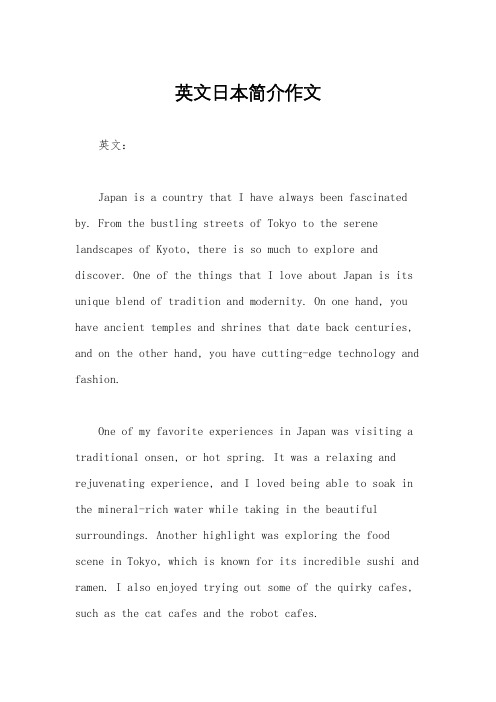
英文日本简介作文英文:Japan is a country that I have always been fascinated by. From the bustling streets of Tokyo to the serene landscapes of Kyoto, there is so much to explore and discover. One of the things that I love about Japan is its unique blend of tradition and modernity. On one hand, you have ancient temples and shrines that date back centuries, and on the other hand, you have cutting-edge technology and fashion.One of my favorite experiences in Japan was visiting a traditional onsen, or hot spring. It was a relaxing and rejuvenating experience, and I loved being able to soak in the mineral-rich water while taking in the beautiful surroundings. Another highlight was exploring the food scene in Tokyo, which is known for its incredible sushi and ramen. I also enjoyed trying out some of the quirky cafes, such as the cat cafes and the robot cafes.Overall, Japan is a country that has so much to offer, and I can't wait to go back and explore more.中文:日本是一个我一直很着迷的国家。
japan
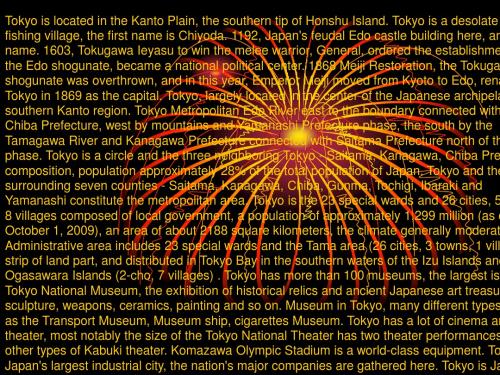
- 1、下载文档前请自行甄别文档内容的完整性,平台不提供额外的编辑、内容补充、找答案等附加服务。
- 2、"仅部分预览"的文档,不可在线预览部分如存在完整性等问题,可反馈申请退款(可完整预览的文档不适用该条件!)。
- 3、如文档侵犯您的权益,请联系客服反馈,我们会尽快为您处理(人工客服工作时间:9:00-18:30)。
Japan is an island country located on the Pacific Ocean, east of China and Korea, stretching from the Sea of Okhotsk in the north to the East China Sea in the south. It is composed of over 3,000 islands, the largest of which are Hokkaidō, Honshū, Shikoku, and Kyūshū. Most of Japan's islands are mountainous, and many are volcanic; the highest peak is Mount Fuji.
JAPAN MARITIME SELF DEFENSE FORCE , JMSDF
JAPAN AIR SELFDEFENCE FORCE ,JASDF
THE IMPERIAL JAPANESE ARMY
帝国军,第二次世界大战之前日本的军队,即天皇统领下的军 队;日本侵略中国期间中国称之为“日寇”。通常指大日本帝 国的军队(即日语中的“大日本帝国陆军、海军”),日军当 时自称“皇军”
THE JAPAN SELF DEFENCE FORCES国家军事武装力量。 日本自卫队属民兵编制,不是正规军,因此日本是一个 名义上没有军队的国家。
JLSDF
编制定员16.7383万人,实有兵员14.5928万人。编成5个军区、11个步兵 师、1个装甲师、1个步兵旅、2个混成旅、1个空降旅、1个炮兵旅、5个工 兵旅、8个防空导弹群。截至1999年3月底,共装备坦克1090辆(90型、 74型),装甲车710辆,自行火炮640辆,各型火炮6240门,各型飞机502 架。
